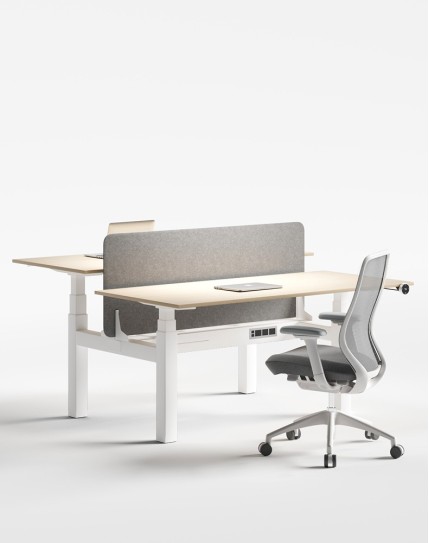
Introduction:
The Height adjustable office desk has become an essential addition to modern workplaces. This innovative desk allows users to seamlessly transition between sitting and standing positions, promoting better posture, reducing back pain, and increasing productivity. Whether you’re in a traditional office or working from home, a height-adjustable desk can bring flexibility, comfort, and health benefits to your workspace.
What is a Height Adjustable Office Desk?
A height-adjustable office desk, often called a sit-stand desk, is designed to let users modify the desk height as needed. These desks generally use either a motorized system or manual adjustment to raise or lower the desk’s surface. This ability to alternate between sitting and standing positions can help alleviate the physical discomfort that often comes with prolonged sitting, such as back pain, neck strain, and fatigue.
Choosing the Right Height Adjustable Office Desk
When selecting a height adjustable desk for your office, several factors can help you find the best fit.
Types of Height Adjustable Office Desks
- Manual Adjustment Desks: These desks use a crank or lever to adjust the height. They’re often more affordable and are suitable for users who don’t need frequent height changes.
- Electric Adjustment Desks: With motorized height adjustment, these desks allow smooth transitions at the push of a button. They are ideal for frequent adjustments and often feature programmable height settings.
- Desk Converters: Desk converters or risers are adjustable platforms that sit on top of an existing desk, letting you elevate your monitor and keyboard for standing use. They’re a cost-effective and space-saving option.
Benefits of Using a Height Adjustable Office Desk
1. Improved Posture and Reduced Pain
One of the main benefits of height-adjustable desks is improved posture. Sitting for extended periods often leads to slouching, which places pressure on the spine and contributes to back and neck pain. With the flexibility to stand, you can break this cycle of poor posture, relieving spinal pressure and reducing the risk of chronic pain.
2. Enhanced Productivity and Focus
Switching between sitting and standing positions can also boost focus and energy levels, leading to increased productivity. Standing improves blood flow, which helps prevent the lethargy that often accompanies long periods of sitting. Height adjustable desks promote movement, keeping you alert and engaged throughout the workday.
3. Supports a Healthier Lifestyle
Height adjustable office desk encourage movement, helping you avoid the health risks associated with a sedentary lifestyle. By reducing sitting time, these desks can improve cardiovascular health, reduce the risk of weight gain, and support long-term wellness. This benefit is especially helpful for those who work in environments where movement is limited.
4. Customizable and Versatile Workspace
Height adjustable desks create a workspace that can adapt to different users’ needs. This is particularly valuable in shared office spaces, as different users can adjust the desk to suit their ergonomic preferences. The desk’s versatility also makes collaborative work easier, as team members can gather comfortably around the desk in either sitting or standing positions.
Features to Look for in a Height Adjustable Desk
To get the most from your height adjustable office desk, consider these key features:
- Height Range: Look for a desk that can accommodate both sitting and standing heights to support your body’s natural posture.
- Weight Capacity: Ensure the desk can hold your equipment, particularly if you use multiple monitors or heavier devices.
- Surface Area: Choose a desk with enough space for your essential work items.
- Speed and Noise: If you choose an electric desk, consider the adjustment speed and noise level to ensure it’s suited to your work environment.
Setting Up Your Height Adjustable Office Desk for Maximum Comfort
Proper setup is essential to maximize the benefits of a height adjustable desk.
Optimal Desk Height
Set your desk so that your elbows rest comfortably at a 90-degree angle when typing, reducing strain on wrists and shoulders. Position your monitor at eye level to prevent neck strain, whether sitting or standing.
Ergonomic Tips for Standing and Sitting Positions
For a comfortable ergonomic experience:
- Alternate Regularly: Change positions every 30–60 minutes to maintain comfort and prevent fatigue.
- Footwear and Flooring: Wear supportive shoes or consider an anti-fatigue mat when standing to reduce strain on your legs and feet.
- Posture Awareness: Maintain a relaxed, upright posture and avoid leaning forward, which can lead to neck and back discomfort.
- Supportive Accessories: Use an ergonomic chair, footrest, or monitor stand to enhance your setup and ensure a comfortable working position.
Conclusion
A height-adjustable office desk is a simple but effective way to combat the challenges of a sedentary work life. By allowing you to alternate between sitting and standing, these desks support better posture, encourage movement, and reduce discomfort. With added focus, versatility, and healthier lifestyle choices, a height-adjustable desk can be an invaluable addition to any office space, helping you create a more dynamic, comfortable, and productive workspace.
